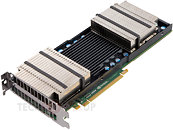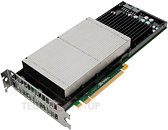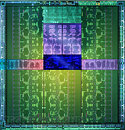- Joined
- Oct 9, 2007
- Messages
- 47,638 (7.44/day)
- Location
- Dublin, Ireland
| System Name | RBMK-1000 |
|---|---|
| Processor | AMD Ryzen 7 5700G |
| Motherboard | Gigabyte B550 AORUS Elite V2 |
| Cooling | DeepCool Gammax L240 V2 |
| Memory | 2x 16GB DDR4-3200 |
| Video Card(s) | Galax RTX 4070 Ti EX |
| Storage | Samsung 990 1TB |
| Display(s) | BenQ 1440p 60 Hz 27-inch |
| Case | Corsair Carbide 100R |
| Audio Device(s) | ASUS SupremeFX S1220A |
| Power Supply | Cooler Master MWE Gold 650W |
| Mouse | ASUS ROG Strix Impact |
| Keyboard | Gamdias Hermes E2 |
| Software | Windows 11 Pro |
NVIDIA today unveiled a new family of Tesla GPUs based on the revolutionary NVIDIA Kepler GPU computing architecture, which makes GPU-accelerated computing easier and more accessible for a broader range of high performance computing (HPC) scientific and technical applications.
The new NVIDIA Tesla K10 and K20 GPUs are computing accelerators built to handle the most complex HPC problems in the world. Designed with an intense focus on high performance and extreme power efficiency, Kepler is three times as efficient as its predecessor, the NVIDIA Fermi architecture, which itself established a new standard for parallel computing when introduced two years ago.



"Fermi was a major step forward in computing," said Bill Dally, chief scientist and senior vice president of research at NVIDIA. "It established GPU-accelerated computing in the top tier of high performance computing and attracted hundreds of thousands of developers to the GPU computing platform. Kepler will be equally disruptive, establishing GPUs broadly into technical computing, due to their ease of use, broad applicability and efficiency."
The Tesla K10 and K20 GPUs were introduced at the GPU Technology Conference (GTC), as part of a series of announcements from NVIDIA, all of which can be accessed in the GTC online press room.
NVIDIA developed a set of innovative architectural technologies that make the Kepler GPUs high performing and highly energy efficient, as well as more applicable to a wider set of developers and applications. Among the major innovations are:
NVIDIA Tesla K10 and K20 GPUs
The NVIDIA Tesla K10 GPU delivers the world's highest throughput for signal, image and seismic processing applications. Optimized for customers in oil and gas exploration and the defense industry, a single Tesla K10 accelerator board features two GK104 Kepler GPUs that deliver an aggregate performance of 4.58 teraflops of peak single-precision floating point and 320 GB per second memory bandwidth.
The NVIDIA Tesla K20 GPU is the new flagship of the Tesla GPU product family, designed for the most computationally intensive HPC environments. Expected to be the world's highest-performance, most energy-efficient GPU, the Tesla K20 is planned to be available in the fourth quarter of 2012.
The Tesla K20 is based on the GK110 Kepler GPU. This GPU delivers three times more double precision compared to Fermi architecture-based Tesla products and it supports the Hyper-Q and dynamic parallelism capabilities. The GK110 GPU is expected to be incorporated into the new Titan supercomputer at the Oak Ridge National Laboratory in Tennessee and the Blue Waters system at the National Center for Supercomputing Applications at the University of Illinois at Urbana-Champaign.
"In the two years since Fermi was launched, hybrid computing has become a widely adopted way to achieve higher performance for a number of critical HPC applications," said Earl C. Joseph, program vice president of High-Performance Computing at IDC. "Over the next two years, we expect that GPUs will be increasingly used to provide higher performance on many applications."
Preview of CUDA 5 Parallel Programming Platform
In addition to the Kepler architecture, NVIDIA today released a preview of the CUDA 5 parallel programming platform. Available to more than 20,000 members of NVIDIA's GPU Computing Registered Developer program, the platform will enable developers to begin exploring ways to take advantage of the new Kepler GPUs, including dynamic parallelism.
The CUDA 5 parallel programming model is planned to be widely available in the third quarter of 2012. Developers can get access to the preview release by signing up for the GPU Computing Registered Developer program on the CUDA website.
View at TechPowerUp Main Site
The new NVIDIA Tesla K10 and K20 GPUs are computing accelerators built to handle the most complex HPC problems in the world. Designed with an intense focus on high performance and extreme power efficiency, Kepler is three times as efficient as its predecessor, the NVIDIA Fermi architecture, which itself established a new standard for parallel computing when introduced two years ago.



"Fermi was a major step forward in computing," said Bill Dally, chief scientist and senior vice president of research at NVIDIA. "It established GPU-accelerated computing in the top tier of high performance computing and attracted hundreds of thousands of developers to the GPU computing platform. Kepler will be equally disruptive, establishing GPUs broadly into technical computing, due to their ease of use, broad applicability and efficiency."
The Tesla K10 and K20 GPUs were introduced at the GPU Technology Conference (GTC), as part of a series of announcements from NVIDIA, all of which can be accessed in the GTC online press room.
NVIDIA developed a set of innovative architectural technologies that make the Kepler GPUs high performing and highly energy efficient, as well as more applicable to a wider set of developers and applications. Among the major innovations are:
- SMX Streaming Multiprocessor -- The basic building block of every GPU, the SMX streaming multiprocessor was redesigned from the ground up for high performance and energy efficiency. It delivers up to three times more performance per watt than the Fermi streaming multiprocessor, making it possible to build a supercomputer that delivers one petaflop of computing performance in just 10 server racks. SMX's energy efficiency was achieved by increasing its number of CUDA architecture cores by four times, while reducing the clock speed of each core, power-gating parts of the GPU when idle and maximizing the GPU area devoted to parallel-processing cores instead of control logic.
- Dynamic Parallelism -- This capability enables GPU threads to dynamically spawn new threads, allowing the GPU to adapt dynamically to the data. It greatly simplifies parallel programming, enabling GPU acceleration of a broader set of popular algorithms, such as adaptive mesh refinement, fast multipole methods and multigrid methods.
- Hyper-Q -- This enables multiple CPU cores to simultaneously use the CUDA architecture cores on a single Kepler GPU. This dramatically increases GPU utilization, slashing CPU idle times and advancing programmability. Hyper-Q is ideal for cluster applications that use MPI.
NVIDIA Tesla K10 and K20 GPUs
The NVIDIA Tesla K10 GPU delivers the world's highest throughput for signal, image and seismic processing applications. Optimized for customers in oil and gas exploration and the defense industry, a single Tesla K10 accelerator board features two GK104 Kepler GPUs that deliver an aggregate performance of 4.58 teraflops of peak single-precision floating point and 320 GB per second memory bandwidth.
The NVIDIA Tesla K20 GPU is the new flagship of the Tesla GPU product family, designed for the most computationally intensive HPC environments. Expected to be the world's highest-performance, most energy-efficient GPU, the Tesla K20 is planned to be available in the fourth quarter of 2012.
The Tesla K20 is based on the GK110 Kepler GPU. This GPU delivers three times more double precision compared to Fermi architecture-based Tesla products and it supports the Hyper-Q and dynamic parallelism capabilities. The GK110 GPU is expected to be incorporated into the new Titan supercomputer at the Oak Ridge National Laboratory in Tennessee and the Blue Waters system at the National Center for Supercomputing Applications at the University of Illinois at Urbana-Champaign.
"In the two years since Fermi was launched, hybrid computing has become a widely adopted way to achieve higher performance for a number of critical HPC applications," said Earl C. Joseph, program vice president of High-Performance Computing at IDC. "Over the next two years, we expect that GPUs will be increasingly used to provide higher performance on many applications."
Preview of CUDA 5 Parallel Programming Platform
In addition to the Kepler architecture, NVIDIA today released a preview of the CUDA 5 parallel programming platform. Available to more than 20,000 members of NVIDIA's GPU Computing Registered Developer program, the platform will enable developers to begin exploring ways to take advantage of the new Kepler GPUs, including dynamic parallelism.
The CUDA 5 parallel programming model is planned to be widely available in the third quarter of 2012. Developers can get access to the preview release by signing up for the GPU Computing Registered Developer program on the CUDA website.
View at TechPowerUp Main Site




 )
)

 /S
/S

 or for that matter even speculated about yet
or for that matter even speculated about yet ).
). ,,you buying this im not and wasnt so to them i matter not but this dosnt scream performance crown to me and double its performance (GK110) and what do you get,,,thats right, it again but finally on 1 chip,,,, Epic Fail imho, though yes they will be economical, just shit.
,,you buying this im not and wasnt so to them i matter not but this dosnt scream performance crown to me and double its performance (GK110) and what do you get,,,thats right, it again but finally on 1 chip,,,, Epic Fail imho, though yes they will be economical, just shit.